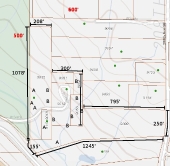posted 8 years ago
One thing they left out is the organic content. Normally that is included, it would be worth knowing. Travis has said what I would have said pretty much, because I have read probably 200 of his posts and he knows his stuff. Bryant will probably pop in here and he is in Arkansas and may have some really good input.
Jayden, I was in your shoes about six months ago, with about six acres of dust bowl. I can send you the sample if you want to see, but basically same pH and even lower CEC. I bit the bullet and limed. Not only did I use regular lime, I also used CalTurf, which is a faster-acting lime, because the pelletized lime takes about six months IMO to really do much, but will release over the timeframe Travis describes. The reason I think it makes sense is that minerals are neither created or destroyed. They can be leached, but once they are gone, they are gone. You may be able to use accumulators like chicory or comfrey to dredge them up from the subsoil, but it will take a long time for the tons you are deficient, and it is controversial if it works. Those deeper soils may be depleted as well, depending on how burned out your land is. I was also deficient in Mag and sulfur, so I used dolomitic lime, but the same principle applies. I am actually concerned about your phosphate levels, as that will compete for uptake with calcium and win on the basis of relative quantity.
With that pH clover will not probably live, so you are left without a very important family. Others in the same family are even more picky (I'm looking at you alfalfa). Without N fixation you will not have carbon growth, and without cover you will have scalded soil until the frontier species can do their thing, which is decades if you are that depleted.
I have looked at doing this the natural way, planting frontier species and doing earthworks, but it is a long horizon. I had an experiment going on with two areas, similar awful samples. One I limed and one I didn't, but I planted some accumulators (chicory and buckwheat, mullein already was present). Preliminarily, the unlimed area was doing so poorly (after earthworks!) that I just limed it too. Literally the limed area has many times the cover on it from the winter crops (which were scientifically chosen by being on clearance), and I feel like if I am doing earthworks (which is pretty unnatural), I might as well restore the minerals and then increase the carbon and CEC in a couple seasons. If you have a lot of acreage and this is a major financial hurdle, or you are philosophically inclined against it, then planting some accumulators and waiting is an option.
Once you have spent that money on the minerals, you need to plant stuff to continually draw them back up as they try to leach out, or have a soil web to do it. Buckwheat is pretty reasonable, germinates OK in my experience from broadcast seeding, and is a great forage and good pollen producer. Unfortunately it is an annual. I did plant some chicory, but it is a lot more expensive and I am lurking around trying to get a good deal. I only have five pounds down so far and it hasn't done much, so I may need to do the bad thing and disturb some strips to get it going. Comfrey so far has not been successful, but only a small scale planting. OK, it's probably dead. Basically you want some plants that have deep roots and participate in the soil food web, and you want them every year. Lots of trees need calcium to prosper and that is part of my long-term plan. I may have to lime every so often, but once I have some organic content in the soil (mine was <2% in both fields), then not as much will be lost. Once I get a viable soil web things should improve.
I will admit I am a bit type A, and some of this is science fair, but $800 in lime to get at least a couple growing seasons ahead made sense to me.
Standing on the shoulders of giants. Giants with dirt under their nails








